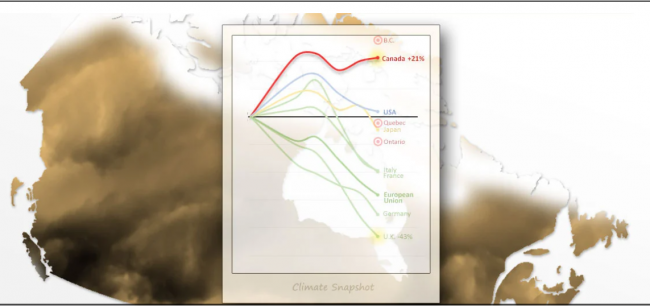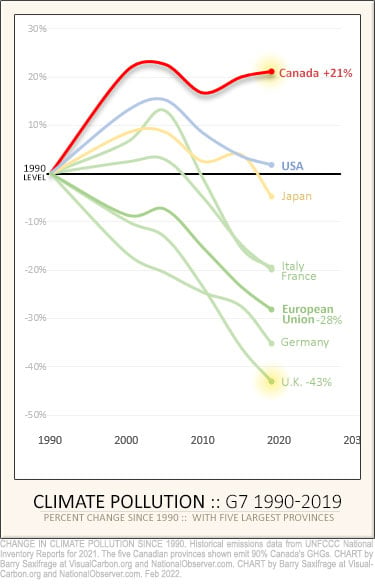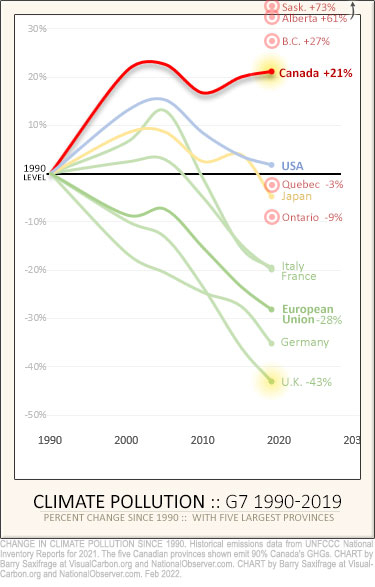Articles Menu

Mar. 23, 2022
Humanity is hurtling towards a full-blown climate crisis. To avoid this dystopian future, climate pollution must rapidly plunge to zero.
Canada and its peer nations in the Group of Seven (G7) — the United States, United Kingdom, Germany, France, Italy and Japan, plus the European Union — are some of the world's largest emitters. Combined, these nations emit one-third of global climate pollution. And in each nation, emissions per person are above the global average.
These are also the world's largest advanced economies, controlling half the world's wealth and producing half the world's GDP. In short, if the world is going to prevent a climate tragedy, these nations with the most resources, talent, technology and capacity will need to lead the way. So how much climate progress have Canada and its G7 peers made so far? Let's take a look.
My chart below shows what each nation has done with their climate pollution since 1990. That's the international baseline for measuring climate progress. The chart ends with 2019 because that is the most recent year for which emissions data is available. As you can see, Canada has been the rogue climate polluter in the group.

Canada first promised to cut our oversized climate pollution in 1988. More than 30 years later, we're the only G7 nation that is still emitting far above our 1990 levels.
Even more troubling has been our failure to act during the last decade. Since 2010, as the climate crisis has started to hit with increasing fury, every other G7 nation has made significant cuts in its emissions — except Canada. Ours went up instead.
Some G7 peers have been making deep and sustained cuts to their emissions for decades now. For example, the European Union as a whole has cut its emissions by 28 per cent since 1990. Germany cut its emissions by 35 per cent. And our Commonwealth peer, the U.K., cut its emissions by 43 per cent.
If the British can do it, surely Canadians can, too. The difference so far has been that the British passed laws that required their emissions to go down. We haven't. In particular, they passed their innovative Carbon Budget law — way back in 2008 — that required legally binding targets covering all emissions in every year. We could have adopted a version of this proven policy package at any point. We still can.
Canada's five biggest provinces emit 90 per cent of the nation's climate pollution. To let you compare their climate progress — or failure — to our G7 peers, I've added a dot for each province on the chart. Three have dramatically increased their emissions. These three provinces have been the primary drivers of Canada's climate failure.
Analysis: Canada is the only G7 nation still emitting far above 1990 levels — and we are still heading in the wrong direction, writes columnist @bsaxifrage. #ClimateCrisis #FossilFuels #Emissions - Twitter

British Columbia's emissions are 27 per cent higher than in 1990. The fact that B.C. has allowed its emissions to surge so high surprises many people I talk to. That's because B.C. was seen as a climate policy leader way back in 2008 when it introduced Canada's first economy-wide "carbon tax."
As you may remember, that was the same year the U.K. introduced its Carbon Budget law. But unlike the British, who followed through, British Columbians quickly slammed the brakes on their climate policy and have allowed their emissions to keep rising instead.
Alberta emits 61 per cent more than in 1990. Its climate polluting has been turbocharged by skyrocketing extraction of fossil fuels — combined with its aggressive hostility towards effective climate policy.
Saskatchewan emits 73 per cent more than in 1990. Like Alberta, this province has been cranking up the climate burner like there is no tomorrow.
In contrast, Canada's two most populous provinces have reduced their annual emissions since 1990.
Quebec's record, though, is a mixed bag. A few years ago, its emissions had fallen to nine per cent below 1990. But rising emissions since have wiped out two-thirds of that progress. Three steps forward, two steps back.
Ontario reduced emissions to nine per cent below 1990. The big caveat here is that all of this — and more — can be attributed to a single policy enacted in 2007: Cessation of Coal Use Regulation. The provincial government calls this the "single largest greenhouse gas (GHG) emissions reduction action on the continent." This one policy eliminated 27 million tonnes of carbon dioxide (CO2) per year. That's substantially more than the province's overall reduction since 1990 of 17 million tonnes of CO2 per year. Without the coal phaseout, Ontario's emissions would be five per cent higher than 1990, instead of nine per cent lower. Now that all its coal-fired power has been shut down, the province will need to introduce strong policies for the other sectors.
We don't have long to wait to see how serious Canada's current federal government is about joining the climate fight. By the end of this month, the Liberals have promised to release their 2030 Emissions Reduction Plan.
Canada's climate pledge for 2030, under the global Paris Agreement, is to cut our oversized climate pollution at least 40 per cent below 2005 levels. That works out to 26 per cent below our 1990 level. As my chart above shows, the British, the Germans and the Europeans overall have already done that much — and more.
But decades of Canadian foot-dragging and broken promises, instead of pollution cuts, have left us still far behind and still heading the wrong way. To finally reverse course and try to catch up to our G7 peers, Ottawa will need to enact strong new climate policies. Our peers, like the U.K., have shown us clearly what kinds of climate policies work. How much worse are we going to let the climate crisis become before we start to act, too?
*****
Endnotes:
[Top image: Canada is the only G7 nation emitting far above 1990 levels — and Alberta, Saskatchewan and B.C. are the main drivers of this climate failure.]